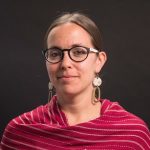How can we best develop structural interventions to enable adolescent contraceptive use in LMICs
Date: 19 July 2022
Reducing adolescent childbearing is a global priority; enabling contraceptive use is one means of achieving this. Upstream factors, such as gender inequalities, fertility norms, poverty, girls’ empowerment and schooling can be major factors affecting contraceptive use; structural interventions aim to address these factors. Structural interventions include those aiming to increase schooling, e.g. through cash transfers or legislation, to increase economic empowerment, e.g. through cash transfers, livelihoods training or employment opportunities, or to change social norms around gender and adolescent sexuality and fertility e.g. through actively engaging community members in dialogue. This webinar looks at what interventions have been evaluated in low- and middle-income countries and what is needed to move the field forward and ensure the best evidence and interventions are conducted in the future.
Speakers

Helen Burchett
Associate Professor, London School of Hygiene and Tropical Medicine
Helen’s main research interests lie in the interplay between context, interventions and people, to understand how or why interventions may work (or not work). An area of special interest is the generalisability or applicability of evaluation research to other settings. She has previously worked in the NHS as a Health Promotion Specialist, for an NGO called The Maternity Alliance as Public Health Policy Officer and as a researcher at the Social Science Research Unit, Institute of Education. Helen worked on systematic reviews, intervention evaluations as well as qualitative and mixed methods research studies
Karen Austrian
Director, GIRL Center, Population Council
Karen Austrian leads the Council’s Girl Innovation, Research, and Learning (GIRL) Center – a global research hub that generates, synthesizes, and translates evidence on adolescents to support investments that transform their lives, especially for girls. Prior to stepping into this role, Austrian led a portfolio of projects designed to empower girls in East and Southern Africa. She develops, implements, and evaluates programs that build girls’ protective assets, such as financial literacy, social safety nets and access to education. Austrian is the principal investigator of two large, longitudinal, randomized trials evaluating the impact of multi-sectoral programs for adolescent girls – the Adolescent Girls Initiative – Kenya and the Adolescent Girls Empowerment Program in Zambia – and also leads the Council’s work assessing the social, health, education and economic effects of COVID-19 on adolescents and their households in Kenya.
Venkatraman Chandra-Mouli
Scientist, Adolescent Sexual & Reproductive Health, World Health Organization (WHO)
Dr Chandra-Mouli leads the work on adolescent sexual and reproductive health (ASRH) in the Department of Reproductive Health and Research at the World Health Organization. His job is to build the epidemiological and evidence base for ASRH and to help countries translate this data and evidence into action through well-designed and well-managed policies and programmes. His experience in this field is global in scope and spans 30 years.
Chair: Isolde Birdthistle
Associate Professor of Adolescent Health and Epidemiology, London School of Hygiene and Tropical Medicine
Professor Birdthistle uses research as a tool to document the needs and solutions for adolescent health. This includes observational research to expose the vulnerability of adolescent girls and young women to early HIV/STI and sexual health risk. She alsos use epidemiological data to generate evidence for ‘what works’, particularly through the evaluation of complex interventions for adolescents. Isolde previously worked in adolescent health promotion programmes with WHO (the Global School Health Initiative), UNICEF (education and HIV prevention), Harvard School of Public Health, and the MIT Media Lab.Useful resources:
Helen’s slides: View here Karen’s slides: View here Further reading from Karen Austrian: Two year/end of intervention results: https://bmcpublichealth.biomedcentral.com/articles/10.1186/s12889-021-12224-3 Four year follow up results in Wajir: https://www.sciencedirect.com/science/article/pii/S1054139X21006856 Four year follow up results in Kibera: https://journals.plos.org/plosone/article?id=10.1371/journal.pone.0262858 Chandra’s slides: View here

